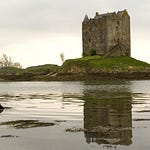Welcome back to "A Scottish Castle, A Day," brought to you by bagtownclans.com. I’m your host, Colin MacDonald, and today we’re taking a journey to the southern shore of the River Clyde, where one of Scotland’s most well-preserved castles stands—Newark Castle. Nestled in the heart of Port Glasgow, Inverclyde, this impressive structure has watched over the Clyde estuary for centuries, from its days as a tranquil trading hub to its evolution into a bustling shipbuilding center.
Newark Castle’s location was strategic—right where the estuary narrows, making navigation upriver to Glasgow difficult due to shifting sandbanks. For many years, this spot served as a critical place for offloading seagoing ships, and it was here that the foundations of Port Glasgow began to take shape. When 18th-century dredging efforts finally allowed larger ships to sail directly to Glasgow, the port around Newark Castle became a key site for Scotland’s flourishing shipbuilding industry. Even today, the echoes of this industrial past are still felt, with Ferguson Shipbuilders—one of the last shipyards on the lower Clyde—standing close by. Yet, the east of the castle has changed dramatically; with the shipyards gone, scenic landscaped areas now offer beautiful views across the Clyde.
Newark Castle was built in 1478 by George Maxwell, after inheriting the Barony of Finlaystone in the nearby parish of Kilmacolm. Originally, the castle would have been quite different from what we see today. The earliest structure was a tower house, surrounded by a defensive enclosure known as a barmkin, which would have included important outbuildings such as a hall, a bakehouse, and perhaps a brew house. While much of the barmkin is gone, one corner tower still survives, offering a glimpse of the castle's medieval defensive nature.
Maxwell’s descendants continued to build on his legacy, particularly in the late 16th century when Newark Castle saw its most significant transformation under Sir Patrick Maxwell. Sir Patrick inherited the castle during a time when Scotland was transitioning from its medieval roots into the Renaissance, and his ambitions for the castle reflected that shift.
In 1597, Sir Patrick Maxwell expanded Newark Castle, turning it into a three-storey Renaissance mansion, much of which stands today. He replaced the earlier hall with a grand north range and demolished much of the outer barmkin wall, sparing only the northeast tower, which was repurposed into a doocot—a type of pigeon house. The expansion introduced key features of the Scottish baronial style, including crow-stepped gables and corbelled turrets, making the castle a blend of medieval fortification and Renaissance grandeur.
At the heart of the mansion, a grand hall with large windows occupies the central part of the building, offering spectacular views of the river and surrounding lands. Below the hall are cellars with small windows, while above, there were living quarters for the Maxwell family. The castle's main entrance sits in the east wing, linking the Renaissance mansion to the original 15th-century tower house. A short west wing connects the main block to the original gatehouse, completing this remarkable transformation.
This grand expansion was a statement of wealth and power, but Sir Patrick Maxwell's personal life was far from serene. Despite being a close ally of King James VI, he was notorious for his violent feud with the Montgomerie family, particularly Robert Montgomerie of Skelmorlie. He also gained a dark reputation for the brutal abuse of his wife, Lady Margaret Crawford, who bore him 16 children before fleeing his cruelty. His legacy, while marked by architectural achievement, is also shadowed by these personal tragedies.
By the late 17th century, Newark Castle had shifted from a private residence to a key part of Scotland’s growing maritime trade. In 1668, the city of Glasgow purchased 18 acres of land surrounding the castle from Sir George Maxwell. This land was developed into a port that soon became known as “Port Glasgow,” and quickly grew into a thriving harbor, critical to the city’s expanding mercantile ambitions.
The castle’s fortunes, however, faded after the last Maxwell passed away in 1694. Over the next centuries, Newark Castle saw a series of non-resident owners and was rented out to tenants. One such tenant was John Gray, a ropemaker who also had a peculiar side business dealing in exotic animals. It’s said that he housed wild cats and bears in the castle cellars—quite a departure from its days as a noble residence! Later, another tenant, Charles Williamson, rented the castle’s gardens and cellars, but blocked access to the hall to prevent a fellow renter, John Gardner, from stealing his stored fruit.
Despite these odd chapters in its history, Newark Castle remained a solid, well-maintained structure. Even in the 19th century, visitors noted the well-preserved stump of the castle’s dule tree, traditionally used for hanging criminals—another reminder of the harsh realities of life in medieval Scotland.
In 1909, Newark Castle was placed into state care and today is managed by Historic Environment Scotland. Visitors to the castle can explore its fascinating mix of medieval and Renaissance architecture, wandering through its grand halls, cellars, and towers. The renovations and landscaping around the site now open up the stunning views across the River Clyde, making it not just a historical visit but also a scenic one.
With excellent visitor facilities in place, Newark Castle remains a striking example of Scottish Renaissance architecture and offers a fascinating glimpse into both the turbulent and prosperous chapters of Scotland’s history. While the shipyards that once surrounded it have mostly disappeared, the castle stands as a testament to Scotland’s maritime past and the enduring legacy of the Maxwell family.
Thank you for joining us on this episode of "A Scottish Castle, A Day." We hope you’ve enjoyed delving into the rich history of Newark Castle with us. Don’t forget to tune in tomorrow as we explore yet another fascinating story from Scotland’s illustrious past. I’m Colin MacDonald, and as always, Slán go fóill.













Share this post